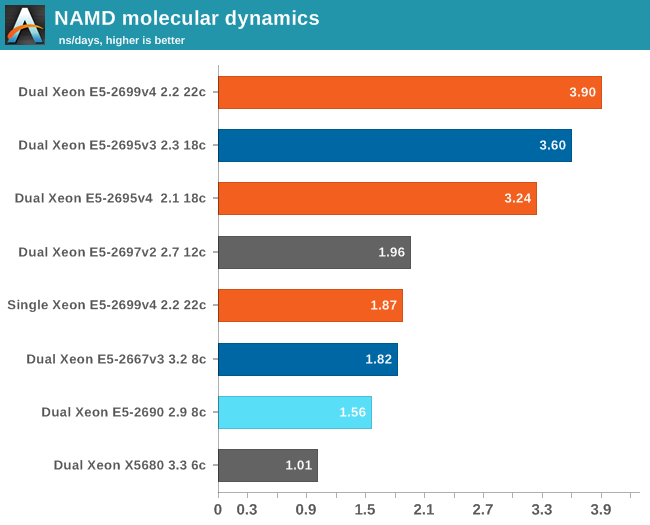The Intel Xeon E5 v4 Review: Testing Broadwell-EP With Demanding Server Workloads
by Johan De Gelas on March 31, 2016 12:30 PM EST- Posted in
- CPUs
- Intel
- Xeon
- Enterprise
- Enterprise CPUs
- Broadwell
Floating Point: NAMD
Developed by the Theoretical and Computational Biophysics Group at the University of Illinois Urbana-Champaign, NAMD is a set of parallel molecular dynamics codes for extreme parallelization on thousands of cores. NAMD is also part of SPEC CPU2006 FP.
We used the "NAMD_2.10_Linux-x86_64-multicore" binary for our Xeons. We used the most popular benchmark load, apoa1 (Apolipoprotein A1). The results are expressed in simulated nanoseconds per wall-clock day.

To put this in perspective: our best Xeon performs slightly slower than the early Xeon Phi (7120 1.2 GHz: 4.4). A top NVIDIA GPU with CUDA based NAMD can score up to 20 and more. So it is clear that this kind of software will be run mostly on GPU accelerated servers and scales "embarrassingly well".
We found out that we can boost the NAMD performance of the Xeon E5 quite a bit by disabling hyperthreading in the BIOS. In this case, core for core, the Broadwell Xeon (Xeon E5-2695 v4) loses compared to the similar Xeon E5-2699v3. Our suspicion that Broadwell does not keep the clockspeeds as high as Haswell seems justified.










112 Comments
View All Comments
Casper42 - Thursday, March 31, 2016 - link
HPE just dropped the 64GB LRDIMMs a week or two back.They are now exactly 2x the 32GB LRDIMM as far as List Price goes.
LRDIMMs across the board are 31% more expensive than RDIMMs.
wishgranter - Tuesday, April 5, 2016 - link
http://www.techpowerup.com/221459/samsung-starts-m...wishgranter - Tuesday, April 5, 2016 - link
While introducing a wide array of 10nm-class DDR4 modules with capacities ranging from 4GB for notebook PCs to 128GB for enterprise servers, Samsung will be extending its 20nm DRAM line-up with its new 10nm-class DRAM portfolio throughout the year.nathanddrews - Thursday, March 31, 2016 - link
Perf/W is obviously a very exciting metric for server farmers and it generally exciting from a basic technology perspective, but it's absolute performance isn't amazing. Anyway, it's not like I'll be buying one anyway. LOLasendra - Thursday, March 31, 2016 - link
This interest me in so far as this would be the updated processors in a supposedly-coming-this-year Mac Pro refresh. Not that I would personally fork that much cash, but I'm interested to see how much of a jump they will make.But things seam rather bleak. No wonder they decided to wait 3 years for a refresh.
MrSpadge - Thursday, March 31, 2016 - link
Not sure which years you're counting in, but for the majority of us it takes 1.5 years from 09/2014 to today.https://en.wikipedia.org/wiki/Haswell_%28microarch...
asendra - Thursday, March 31, 2016 - link
Apple didn't update the MacPros with Haswell-EP. They are still using Ivy Bridgetipoo - Thursday, March 31, 2016 - link
Wonder what they'll do on the GPU side though. Too early for next generation 14nm FF GPUs from anyone, if Nvidia was even a choice due to OpenCL politics. Another GCN 1.0 part in 2016 would be...A bag of hurt.
Still waiting on the high end 15" rMBP to have something better than GCN 1.0...The performance, shockingly, hasn't come all that far from even my Iris Pro model. Maybe double, which is something, but I'd like larger than that to upgrade from integrated...
extide - Thursday, March 31, 2016 - link
Nah, if they refresh it late this year, like in august or something like that, then 14/16nm FF GPU's will be available.At worst we would get GCN 1.2, but yeah it would suck to see 28nm GPU's put in there...
mdriftmeyer - Thursday, March 31, 2016 - link
On what planet do you not grasp FinFET 14nm end of June from AMD?